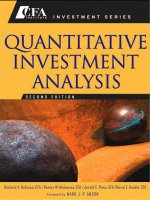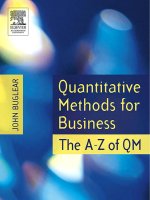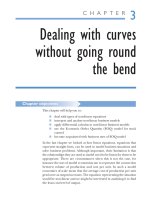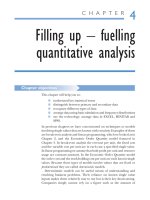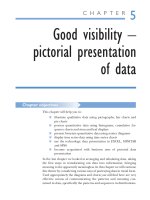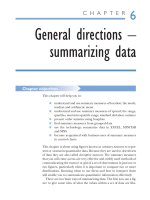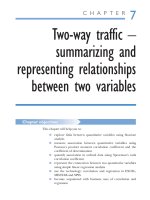Quantitative Methods for Business chapter 1 ppsx
Bạn đang xem bản rút gọn của tài liệu. Xem và tải ngay bản đầy đủ của tài liệu tại đây (368.86 KB, 46 trang )
Quantitative Methods for
Business
This Page Intentionally Left Blank
Quantitative
Methods for
Business
The A–Z of QM
John Buglear
AMSTERDAM • BOSTON • HEIDELBERG • LONDON • NEW YORK • OXFORD
PARIS • SAN DIEGO • SAN FRANCISCO • SINGAPORE • SYDNEY • TOKYO
Elsevier Butterworth-Heinemann
Linacre House, Jordan Hill, Oxford OX2 8DP
30 Corporate Drive, Burlington, MA 01803
First published 2005
Copyright © 2005, John Buglear. All rights reserved
The right of John Buglear to be identified as the author of this work
has been asserted in accordance with the Copyright, Designs and
Patents Act 1988
No part of this publication may be reproduced in any material form
(including photocopying or storing in any medium by electronic means
and whether or not transiently or incidentally to some other use of this
publication) without the written permission of the copyright holder except
in accordance with the provisions of the Copyright, Designs and Patents
Act 1988 or under the terms of a licence issued by the Copyright Licensing
Agency Ltd, 90 Tottenham Court Road, London, England W1T 4LP.
Applications for the copyright holder’s written permission to reproduce
any part of this publication should be addressed to the publisher
Permissions may be sought directly from Elsevier’s Science &
Technology Rights Department in Oxford, UK: phone: (ϩ44) 1865 843830,
fax: (ϩ44) 1865 853333, e-mail: You may also
complete your request on-line via the Elsevier homepage (),
by selecting ‘Customer Support’ and then ‘Obtaining Permissions’
British Library Cataloguing in Publication Data
A catalogue record for this book is available from the British Library
Library of Congress Cataloguing in Publication Data
A catalogue record for this book is available from the Library of Congress
ISBN 0 7506 5898 3
Printed and bound in The Netherlands
For information on all Elsevier Butterworth-Heinemann publications visit our
website at
Contents
Preface xi
Acknowledgements xiii
Chapter 1 Setting off 1
1.1 Quantitative methods, numbers and business 1
1.2 Using this book 3
1.3 Key arithmetical procedures 5
1.4 Using the technology: calculators, EXCEL,
MINITAB and SPSS 23
Review questions 26
Chapter 2 Getting linear models straight 32
2.1 Linear equations 33
2.2 Simultaneous equations 41
2.3 Break-even analysis 46
2.4 Inequalities 50
2.5 Linear programming 57
2.6 Using the technology: Solver in EXCEL 68
2.7 Road test: Do they really use linear programming? 72
Review questions 74
Chapter 3 Dealing with curves without going round the bend 81
3.1 Simple forms of non-linear equations 82
3.2 Basic differential calculus 87
3.3 The Economic Order Quantity model 92
3.4 Road test: Do they really use the Economic Order
Quantity model? 99
Review questions 102
Chapter 4 Filling up – fuelling quantitative analysis 108
4.1 Some key words you need to know 109
4.2 Sources of data 111
4.3 Types of data 111
4.4 Arrangement of data 116
4.5 Using the technology: arranging data in EXCEL,
MINITAB and SPSS 123
Review questions 128
Chapter 5 Good visibility – pictorial presentation of data 135
5.1 Displaying qualitative data 136
5.2 Displaying quantitative data 143
5.3 Presenting bivariate quantitative data 157
5.4 Presenting time series data 160
5.5 Using the technology: presenting data in EXCEL,
MINITAB and SPSS 162
5.6 Road test: Do they really use pictorial presentation? 169
Review questions 170
Chapter 6 General directions – summarizing data 177
6.1 Measures of location 178
6.2 Measures of spread 194
6.3 Using the technology: summarizing data in EXCEL,
MINITAB and SPSS 211
6.4 Road test: Do they really use summary measures? 213
Review questions 215
Chapter 7 Two-way traffic – summarizing and representing
relationships between two variables 223
7.1 Correlation analysis 224
7.2 Simple linear regression analysis 237
7.3 Using the technology: correlation and regression in
EXCEL, MINITAB and SPSS 244
7.4 Road test: Do they really use correlation and regression? 247
Review questions 248
vi Contents
Chapter 8 Counting the cost – summarizing money
variables over time 255
8.1 Index numbers 256
8.2 Investment appraisal 261
8.3 Using the technology: investment appraisal in EXCEL 273
8.4 Road test: Do they really use investment appraisal? 274
Review questions 275
Chapter 9 Long distance – analysing time series data 285
9.1 Components of time series 286
9.2 Classical decomposition of time series data 288
9.3 Exponential smoothing of time series data 303
9.4 Using the technology: time series analysis
in MINITAB and SPSS 306
9.5 Road test: Do they really use forecasting? 309
Review questions 310
Chapter 10 Is it worth the risk? – introducing probability 316
10.1 Measuring probability 318
10.2 The types of probability 321
10.3 The rules of probability 324
10.4 Tree diagrams 336
10.5 Road test: Do they really use probability? 339
Review questions 339
Chapter 11 Finding the right way – analysing decisions 347
11.1 Expectation 347
11.2 Decision rules 349
11.3 Decision trees 353
11.4 Road test: Do they really use decision analysis? 363
Review questions 365
Chapter 12 Accidents and incidence – discrete probability
distributions and simulation 374
12.1 Simple probability distributions 375
12.2 The binomial distribution 381
12.3 The Poisson distribution 386
Contents vii
12.4 Simulating business processes 389
12.5 Using the technology: discrete probability
distributions and random number generation
in EXCEL, discrete probability distributions in
MINITAB and SPSS 393
12.6 Road test: Do they really use discrete probability
distributions and simulation? 397
Review questions 398
Chapter 13 Smooth running – continuous probability
distributions and basic queuing theory 405
13.1 The normal distribution 406
13.2 The Standard Normal Distribution 409
13.3 The exponential distribution 421
13.4 A simple queuing model 423
13.5 Using the technology: continuous probability
distributions using EXCEL, MINITAB and SPSS 425
13.6 Road test: Do they really use the normal distribution? 427
Review questions 428
Chapter 14 Getting from A to B – project planning
using networks 435
14.1 Network analysis 436
14.2 Critical path analysis 441
14.3 The Program Evaluation and Review
Technique (PERT) 446
14.4 Cost analysis: crashing the project duration 451
14.5 Road test: Do they really use critical path analysis
and PERT? 453
Review questions 454
Chapter 15 Taking short cuts – sampling methods 466
15.1 Bias in sampling 467
15.2 Probabilistic sampling methods 470
15.3 Other sampling methods 475
15.4 Using the technology: random sample selection in
MINITAB and SPSS 478
15.5 Road test: Do they really use sampling? 480
viii Contents
Chapter 16 Test driving – sampling theory, estimation and
hypothesis testing 482
16.1 Sampling distributions 483
16.2 Statistical inference: estimation 492
16.3 Statistical inference: hypothesis testing 507
16.4 Using the technology: the t distribution, estimation
and hypothesis testing in EXCEL, MINITAB and SPSS 523
16.5 Road test: Do they really use small sample
inference?: the business origins of the t distribution 528
Review questions 529
Chapter 17 High performance – statistical inference for
comparing population means and bivariate data 539
17.1 Testing hypotheses about two population means 540
17.2 Testing hypotheses about more than two population
means – one-way ANOVA 546
17.3 Testing hypotheses and producing interval estimates
for quantitative bivariate data 554
17.4 Contingency analysis 569
17.5 Using the technology: testing differences between
population means and inference with bivariate data in
EXCEL, MINITAB and SPSS 576
17.6 Road test: Do they really use contingency analysis? 586
Review questions 588
Chapter 18 Going off-road – managing quantitative research
for projects and dissertations 597
18.1 Using secondary data 599
18.2 Collecting primary data 601
18.3 Presenting your analysis 611
Appendix 1 Statistical and accounting tables 616
Table 1 Present values 617
Table 2 Binomial probabilities and cumulative
binomial probabilities 618
Table 3 Poisson probabilities and cumulative
Poisson probabilities 619
Table 4 Random numbers 620
Contents ix
Table 5 Cumulative probabilities for the Standard
Normal Distribution 621
Table 6 Selected points of the t distribution 623
Table 7 Selected points of the F distribution 624
Table 8 Selected points of the chi-square distribution 625
Appendix 2 Answers and selected worked solutions to
review questions 626
References 673
Index 679
x Contents
Preface
Quantitative Methods for Business provides an understanding of quantitative
business techniques. As the sub-title, The A–Z of QM suggests, the book is
an accessible guide to the use of a wide variety of quantitative methods that
have important and varied business applications. A range of techniques
are discussed and demonstrated using worked examples, all set in business
contexts. There are ‘road test’ sections where real uses of the techniques
are described.
Quantitative Methods for Business is intended to help readers to use computer
software to carry out quantitative work. It provides guidance on the use of the
EXCEL, MINITAB and SPSS software packages.
Answers to all review questions, including many fully-worked solutions,
are included. These will help readers monitor their own progress and make
the book an effective basis for independent learning.
This Page Intentionally Left Blank
Acknowledgements
I would like to thank Maggie Smith and Deena Burgess at Elsevier for their
support and Elaine Leek for her diligence.
I am grateful to those who reviewed sections of the manuscript for their
helpful observations. Particular thanks are due to Heather Owen (Napier
University),to Dr Michael Cox (Newcastle University) and to Philip Entwistle
and Kazem Shamshiri (University College, Northampton).
Thanks also to my colleagues at Nottingham Trent University. Many of the
ideas in this book have evolved through the experience of working with
these colleagues and our development of new approaches to teaching and
learning quantitative methods.
Finally, thanks to Allison, Max and Tom for their forbearance.
This Page Intentionally Left Blank
CHAPTER
Setting off
1
Chapter objectives
This chapter will help you to:
■ assess the importance businesses attach to quantitative methods
■ make full use of this book
■ apply arithmetical procedures
■ use the technology: calculators and computer software
Beginning a new programme of study is always something of a chal-
lenge. To help ease you into the study of quantitative methods this
chapter begins with an outline of the importance of numbers in busi-
ness life. Following that is an overview of this book and ways in which it
can assist in your studies. The next section provides guidance on arith-
metical procedures that feature in the techniques you will meet in later
chapters. The chapter closes with advice on the use of calculators and
software that can take the hard graft out of the analysis to allow you to
concentrate on interpreting the results.
1.1 Quantitative methods, numbers
and business
If you are studying business or interested in any aspect of business you
need to know about quantitative methods. Why? Because business is all
about quantities: quantities of goods produced and services provided,
quantities of inputs and costs, quantities of revenues and profit, and so on.
How many times have you seen a news programme that does not
mention numbers? How many times have you read a newspaper in
which no numbers are quoted? Numbers are integral to our way of life,
2 Quantitative methods for business Chapter 1
our understanding of the world around us. This is especially so of the
business world that, now and in the future, we relate to as customers,
employees, suppliers.
Consider how numbers played a part in the publisher’s decision to
produce this book. They were interested in the size of the potential
market, which meant looking at the number of students on business
courses. They needed to set a price, which led them to consider the
prices of rival texts on the one hand and their own production costs on
the other. The production costs would depend in turn on the number
of pages in the book and the number of copies to be produced.
You may feel rather uncomfortable at the prospect of studying numer-
ical subjects. Perhaps memories of Maths at school have left a legacy
that leads you to associate analysing numbers with mental numbness.
If this is what happened to you, it is best to try to put it behind you. For
one thing the focus you will find here is on applications and interpret-
ation rather than proof and derivation. It may help to bear in mind
that employers consistently identify numerical and problem-solving skills
as highly desirable qualities in potential employees, so try to think of
your quantitative studies as building a valuable career asset. For example,
in graduate recruitment literature the Exxon Mobil Corporation state
that ‘Numerical and analytical skills are essential for all vacancies’
(Hobsons, 2002, p. 320).
If you do approach the study of quantitative methods with trepida-
tion you may be tempted to think that this is a subject that really doesn’t
matter because it is of no use to businesses. It might be comforting
to think that the subject is irrelevant because this would excuse not
bothering with it. In fact the subjects that you will meet in this book
have in many cases been forged in and grown up with the business
world. The origins of many of the techniques described in this book
are embedded in the history of business sectors as diverse as brewing
and insurance.
This is not an opinion held only by people who teach it; a number of
researchers have tried to establish the use that companies make of
quantitative methods. Usually these studies are aimed at finding how
widespread is the use of a particular type of technique, but occasionally
researchers canvass the application of the spectrum of techniques that
comprise quantitative methods. One comprehensive study was a survey
of American companies undertaken in the 1980s (Kathawala, 1988).
Kathawala surveyed US companies that were in the ‘Fortune 500’.
Fortune is an American business magazine that periodically compiles
lists of the most prominent companies in the USA. He sent question-
naires to firms in the manufacturing and service sectors, as well as a
random sample of small companies. Respondents were asked about
the extent to which they used a variety of quantitative techniques.
Thirteen of these techniques feature in this book. Approximately
half or more of the respondents’ organizations put the majority of these
to moderate, extensive or frequent use. Some were very widely used; in
the case of forecasting only 6% of respondents reported little or no use.
Kathawala found that in general large companies were more likely to
use quantitative methods than small companies. He also found that
some techniques were widely used in certain sectors; for example, all
respondents from the retailing sector reported that they used stock
control methods, whereas all the life insurance companies said they
used computer simulation.
One interesting aspect of Kathawala’s study was the reasons com-
panies gave for not using quantitative techniques. Foremost among these
were that managers lacked knowledge of them. In other words, many
respondents who reported that particular techniques were not used
said that it was because they had no training in them, not that the tech-
niques were considered to be of no value.
The comprehensive nature of the study makes Kathawala’s work
interesting, but it is now some years old. However, in the years since it
was published the quality and availability of computer software that
performs quantitative analysis has vastly improved, suggesting that the
use to which businesses put quantitative methods has increased rather
than decreased.
1.2 Using this book
This first chapter constitutes a prologue or launch pad for your studies.
It is designed to help you start with an idea of the relevance of the sub-
ject, an outline of the structure and approach used in this book, and
what might be termed a refresher course in the basic ‘tools of the trade’.
Chapters 2 and 3 cover simple deterministic models that can help to
represent and understand business operations. The term deterministic
is used because the numbers used in such models are fixed or pre-
determined. Chapters 4 to 9 introduce descriptive techniques, methods
that will enable you to arrange or analyse sets of figures in ways that help
to describe the situation being studied. These are important because
typically figures do vary and the way in which they vary is of interest.
Chapters 10 to 14 deal with techniques and models that allow the
risk inherent in business situations to be reflected in the analysis of
Chapter 1 Setting off 3
them. Chapters 15 to 17 are about inferential techniques, methods that
enable you to make inferences or draw conclusions about an issue in
general based on the study of a comparatively modest amount of data.
The final chapter is designed to help you tackle numerical aspects of
the sort of project or dissertation that you will probably be asked to
write towards the end of your course.
The book will introduce you to a variety of analytical techniques
drawn from the fields of Business Mathematics, Operational Research
and Statistics that together constitute a ‘tool-kit’ of methods that can
be used to investigate situations and help solve problems. Like any other
tool-kit, the key to using it properly is to know not only what each tool
does, but also how and when to use it. The book will help you develop
this ability by illustrating the application of the methods described using
business contexts.
To help you appreciate the wider relevance of the methods you will
meet, there are sections identified as Road tests. These are outlines of
applications of the techniques in the business world, drawn from the
publications of those who undertook the work. The original sources
are listed in the References at the back of the book.
These sections are intended to reassure you that these techniques
are important and so your study of them is not in vain. Some of the
sources used were published some time ago and describe pioneering
work with the techniques concerned; in such cases the use of the tech-
niques has become so commonplace that it does not merit publication.
In other cases commercial confidentiality means that illustrative rather
than actual data has had to be used. These published accounts of the
application of quantitative methods are really only the tip of a sizeable
iceberg; the everyday use of the techniques you will be studying is vast,
but unseen.
Techniques will be explained and demonstrated using worked
examples. Calculations will be outlined in words before symbols are used
to represent the process. Techniques will be explained and demonstrated
using worked examples. Solutions to these worked examples will be
precise or accurate to three decimal places, unless otherwise stated.
Being able to apply a technique, to produce the correct result from
a calculation, is important, especially if you find ‘learning by doing’
useful, but it is by no means all that is involved. It is even more import-
ant to be able to interpret the results that the technique has enabled
you to produce and to communicate the meaning of those results.
In your future career you may be asked to apply techniques of analysis
but you are much more likely to need to be able to explain results, perhaps
to judge whether appropriate techniques have been used to produce
4 Quantitative methods for business Chapter 1
Chapter 1 Setting off 5
Example 1.1
A sales manager has to drive to a regional office from the company headquarters. The
route involves driving 7 miles to a motorway junction, 15 miles along the motorway,
4 miles along a major road, and finally 3 miles across a city. What is the total length of
the journey?
You can get the answer by adding together the distances for the four parts of the
journey.
Total distance ϭ 7 ϩ 15 ϩ 4 ϩ 3 ϭ 29 miles
them. The book therefore provides you with not only a description of
each technique and an illustration of its use, but also a discussion of
the types of results you could get, and what each of them would mean.
At the end of each chapter there are review questions that you can use
to confirm your understanding of the methods and ideas featured in
the chapter. Questions that relate to particularly important aspects of the
chapter content are flagged as Key questions. You can find fully worked
solutions to these key questions and answers to the other review ques-
tions at the back of the book alongside which you will find references
to examples in the chapter. In each case the example is very similar to
the question, so that if you do not obtain the correct answer you can
refer to the example for guidance. All numerical answers are precise or
accurate to at least three decimal places unless stated otherwise.
1.3 Key arithmetical procedures
Certain numerical operations feature in many of the techniques that
you will meet later on, so this section is designed to help remind you of
them and introduce you to some you may not have met.
1.3.1 Addition and subtraction
Addition, represented by the plus sign ‘ϩ’, is the process of putting
two or more numbers together to make a sum or total. As long as the
numbers being added together are positive, i.e. more than zero, the
resulting total grows as more numbers are added.
Although you are probably already familiar with addition, you may not
have encountered the symbol called ‘sigma’, which is used to represent
it. Sigma is the letter capital S from the Greek alphabet, written as ‘⌺’.
It is the letter s because s is the first letter of the word ‘sum’. It is a
Greek letter because at the time that many quantitative techniques
were developed, the ‘classical’ languages of the ancient world were
taught in schools and universities. The Greek language, with its spe-
cific alphabet, provided the pioneers of these techniques with a source
of distinctive symbols.
Although it may seem that the use of letters and symbols by math-
ematicians is a conspiracy to intimidate the rest of the world, actually
they distil the essence of an operation from what would otherwise be a
mass of words. The symbol ⌺ (sigma) simply stands for ‘the sum of’. It
is a form of shorthand that is used for convenience. Similarly letters are
often used in numerical subjects to represent quantities, sometimes to
abbreviate a procedure involving specific numbers and sometimes to
represent a procedure in general. For instance,
Sometimes it is important to identify precisely which of a set of num-
bers are to be added together. To show this, the letter ‘i’ is used to
count the numbers, for example,
The expression ‘i ϭ 1’ below the sigma tells us to start the addition
with the first number and the ‘3’ above the sigma sign tells us to finish
the addition with the third.
x
i
iϭ1
means ‘the sum of the first to the third numbers’.
3
∑
x
x
∑
means ‘the sum of a series of numbers, each of
which are represented by the letter ’.
6 Quantitative methods for business Chapter 1
Example 1.2
In the situation described in Example 1.1, we could show that the total distance travel-
led (which we could represent by ‘D’) is the sum of the distance for the four parts of
the journey (represented by d
1
, d
2
etc.) using the expression:
Dddddd
i
i
7 15 4 3 29
1
4
1234
ϭ ϭ ϩ ϩ ϩ ϭϩ ϩϩϭ
ϭ
∑
If we want to indicate that all of a set of numbers should be added
together and we don’t know exactly how many there are, we can use
the letter ‘n’ to represent the last number in the set, so
At first these types of symbol may appear strange to you, but it
is worth learning to recognize and use them as they can become very
useful shorthand forms which will save you space and time in future
work.
Subtraction, represented by the minus sign ‘Ϫ’, is the process of
subtracting or ‘taking away’ one or more numbers from another. As
long as the numbers being subtracted are positive, i.e. more than zero,
the result reduces as more numbers are subtracted.
An alternative approach to this operation is to add the orders first
and then subtract the total orders from the initial stock. This would be
written as:
Stock at the end of the month ϭ 49 Ϫ (11 ϩ 6 ϩ 9 ϩ 13)
ϭ 49 Ϫ 39 ϭ 10
The round brackets dictate that the operations shown within them
have to be carried out first. They are used to indicate priority.
You may well find addition and subtraction fairly easy, but there are
cases where they are not so straightforward; first, when negative num-
bers are involved, and second when the operation involves numbers
measured in awkward units, e.g. minutes and hours.
Addition and subtraction may give you some difficulty if negative
numbers are involved. If a negative number is added to a total, it reduces
the total.
x
i
i
n
ϭ1
means ‘the sum of the first to the last of the numbers’.
∑
Chapter 1 Setting off 7
Example 1.3
An on-line music business has a stock of 49 copies of a CD at the beginning of February.
In the first week of the month it received orders for 11 copies, in the second week
orders for 6 copies, in the third week orders for 9 copies and in the final week orders
for 13 copies. How many copies will be left in stock at the end of the month?
You can get the answer by subtracting the orders from the initial stock:
Stock at the end of the month ϭ 49 Ϫ 11 Ϫ 6 Ϫ 9 Ϫ 13 ϭ 10
Here round brackets have been used, both to highlight the fact that
there is a negative number in the sequence and to indicate that it must
be dealt with first. This means deciding how to tackle the apparently
contradictory ‘ϩϪ’ sequence of symbols. In fact the minus sign over-
rides the plus sign, so adding a negative number is the same as sub-
tracting a number. The arithmetical expression used to find the total
amount in Example 1.4 has exactly the same result as the following
expression, which combines addition and subtraction:
Total bill ϭ £2.50 ϩ £1.50 ϩ £3 ϩ £3 Ϫ £3 ϭ £7
But what do you do if you have to subtract a negative number? In fact
subtracting a negative number produces the same result as adding a
positive number.
You get exactly the same result if you simply add the amount con-
cerned, £3.
You may find it helpful to think of the two minus signs ‘cancelling
each other out’ to leave you with an addition. This is rather like the
interpretation of double negatives in the English language where, for
instance the sentence ‘I won’t do it for nothing’ means ‘I want some-
thing’. Alternatively it may help to think that taking away a negative is
always positive.
8 Quantitative methods for business Chapter 1
Example 1.4
A customer purchases four items in a supermarket: a pizza costing £2.50, milk costing
£1.50, and two deodorants costing £3 each. The deodorants are on a ‘two-for-one’ spe-
cial offer. What is the total bill the customer should expect?
Because the till adjusts for the special offer after the second deodorant has been
scanned, the answer might be written as:
Total bill ϭ £2.50 ϩ £1.50 ϩ £3 ϩ £3 ϩ (Ϫ£3) ϭ £7
Example 1.5
The till operator notices that the deodorants the customer has selected are not those
on special offer, the offer applies to a similar product. How will this change the total bill?
The special offer reduction of £3 has to be taken from the previous total, so now:
Total bill ϭ £7 Ϫ (Ϫ£3) ϭ £10
Addition and subtraction involving time is something many people
find difficult because time is measured in hours made up of sixty min-
utes, and minutes made up of sixty seconds, rather than nice neat
numerical parcels of ten. The use of the 24-hour clock on top of all this
is simply too much for many people.
It may be more useful to express the answer in hours and minutes. To
do this we need to find how many lots of sixty minutes there are in 164
minutes. The answer is two, so the total journey time is two hours (120
of the total number of minutes) and 44 minutes (the number of min-
utes left over if 120 is subtracted from 164).
But if the driver started the route at 11.45am what time would she
get back to the depot? This is a little more complicated because the
Chapter 1 Setting off 9
Example 1.6
A parcel delivery driver has to deliver packages to four customers. From the depot it
takes 15 minutes to reach the first, a further 40 minutes to reach the second, a further
12 minutes to reach the third, and a further 27 minutes to reach the fourth. It takes
1 hour 10 minutes to reach the depot from the last customer. What is the total driving
time?
To get the answer we can express all the times mentioned, including the duration of
the last stage, in minutes.
Total journey time ϭ 15 ϩ 40 ϩ 12 ϩ 27 ϩ 70 ϭ 164
Example 1.7
If the driver in Example 1.6 starts at 11am, at what time will she arrive back at the depot
(assuming the time for delivering packages from the van is negligible), and what time
is this on the 24-hour clock?
To get the answer, work in hours first, then minutes:
Arrival time ϭ 11 ϩ 2 hours ϭ 1pm
ϩ44 minutes ϭ 1.44 pm
To express this using the 24-hour clock, add 12 to the number of hours, because the
arrival time is after midday:
Arrival time ϭ 1.44 ϩ 12 ϭ 13.44
departure time and total journey time are measured in both hours and
minutes. To find the answer we can start by adding the hours:
11 ϩ 2 ϭ 13
Then add the minutes together:
45 ϩ 44 ϭ 89
Since this amount of minutes is more than 60, i.e. longer than an hour,
we have to express it in hours and minutes, and add the result to the
sum of the hours:
89 minutes ϭ 1 hour and 29 minutes
13 ϩ 1 ϭ 14 hours
ϩ 29 minutes ϭ 14.29, or 2.29pm.
1.3.2 Multiplication and division
Multiplication, or ‘times-ing’, represented either by the asterisk ‘*’ or
the ‘times’ sign ‘ϫ’, is the process of multiplying two or more numbers
together. The result is called the product. If a number is multiplied by
another number that is greater than one, the product will be greater
than the original number.
In this case the number of litres is greater than the number of
quarts, the product represents a numerical increase. But if you multi-
ply a number by another number that is less than one, you will get a
product that is lower than your first number.
10 Quantitative methods for business Chapter 1
Example 1.8
A domestic heating supplier is replacing gas boilers in a housing complex. A new boiler
can supply up to 15 litres of hot water per minute. According to the original specifica-
tions an old boiler could supply up to 14 quarts of hot water per minute. There are
1.137 litres in a quart. Will a new boiler supply hot water at a greater rate than an old one?
We need to convert the quarts given for an old boiler into litres by multiplying the
number of quarts by the conversion rate:
Litres per minute ϭ 14 * 1.137 ϭ 15.918
We can conclude that a new boiler will not supply hot water at a greater rate than an
old one.


